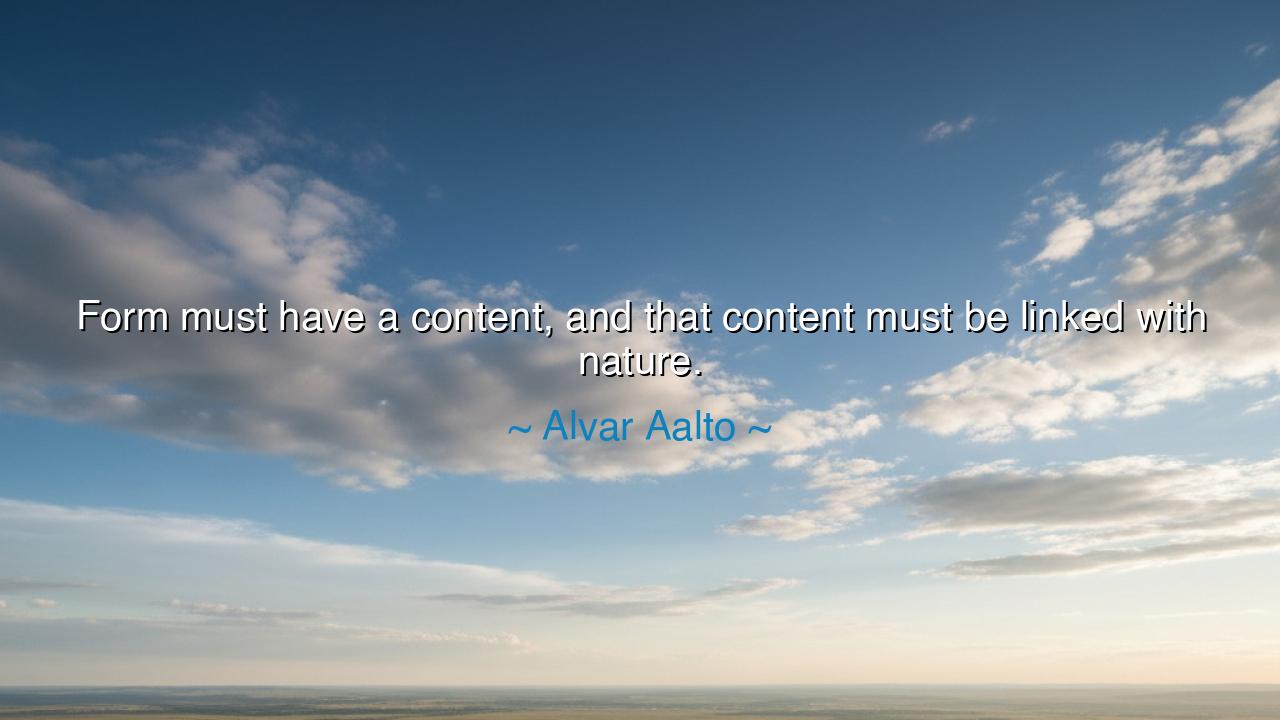
Form must have a content, and that content must be linked with






Alvar Aalto, master of architecture and shaper of spaces that breathe, once declared: “Form must have a content, and that content must be linked with nature.” In this utterance lies not merely an instruction for builders, but a truth for all who create, live, or dream. For he teaches that form—the outward shape, the appearance, the vessel—is empty unless it bears content, and that content cannot be arbitrary, but must be rooted in nature, the eternal source of harmony and truth.
The origin of this teaching is found in Aalto’s philosophy of design. Living in Finland, surrounded by forests, lakes, and northern skies, he saw that architecture was not meant to dominate nature but to converse with it. The walls of a home, the curve of a chair, the flow of a public building—these were not meant to be lifeless shells, but forms animated by a deeper essence. And that essence was always tied to nature’s rhythms: light, wood, water, stone, the human body itself. Without this link, architecture was sterile. With it, architecture became humane, alive, and timeless.
History gives us luminous examples of this wisdom. Consider the temples of ancient Greece, where columns rose like trees, and open courtyards welcomed the sun and air. Their forms had meaning because they echoed nature’s own proportions and balance. Or think of the Japanese tea house, built with simplicity, paper screens, and natural timber, where silence and shadow are as important as the structure itself. In both, we see what Aalto knew: when form is joined to nature, it nourishes the soul, not only the body.
The meaning of this teaching is deeply emotional and powerful. It reminds us that beauty without essence is an illusion. A building may gleam with steel and glass, but if it does not speak to the needs of human life, if it does not harmonize with its surroundings, it is hollow. In the same way, a person may adorn himself with titles, wealth, or appearances, but without content—without depth, without connection to truth and nature—he is but a form without a soul. Aalto’s words are thus not only for architects, but for all humanity: form must serve content, and content must be rooted in what is real.
There is also a heroic restraint in his wisdom. For man is ever tempted to impose, to shape the world by force, to build towers that scream of ambition rather than harmony. But Aalto calls us back to humility: let your form be guided not by ego, but by nature; let your creation echo the rivers, the trees, the horizon. In this way, both the maker and the dweller find peace. The form becomes not an obstacle, but a bridge between man and the eternal order.
The lesson for us is clear: in all that we do, let our outward form reflect an inward essence, and let that essence draw its strength from nature. If you build, build with respect for the land. If you create, let your work breathe with life, not vanity. If you live, let your actions be more than appearance—let them carry true content, shaped by compassion, humility, and truth. For only then will your form endure.
Practically, this means choosing simplicity over excess, harmony over domination. In your home, bring in light, air, and natural materials that remind you of the world beyond walls. In your work, let substance precede appearance—ask not only how it looks, but what it means. In your life, seek authenticity: let your words and deeds align, as form aligns with content, and as content aligns with nature. For when all three are joined, beauty, truth, and peace are born together.
Thus Alvar Aalto’s words remain a guiding flame: “Form must have a content, and that content must be linked with nature.” This is not only the law of architecture, but the law of life. Honor it, and your works—whether of stone, word, or deed—will not be hollow monuments, but living forms, filled with meaning, grounded in the eternal wisdom of nature.






AAdministratorAdministrator
Welcome, honored guests. Please leave a comment, we will respond soon